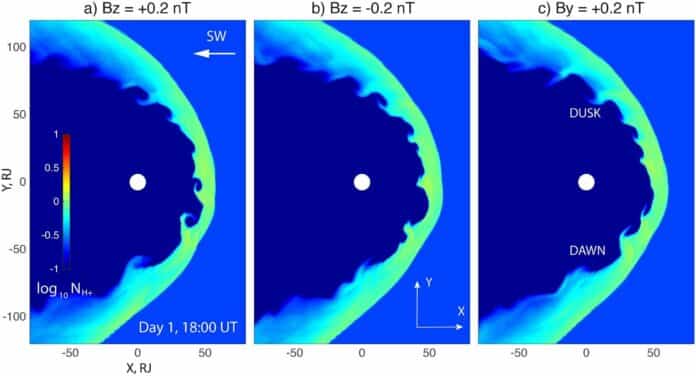Plasma inside Jupiter’s magnetosphere is primarily confined to the equatorial or low latitude region, forming a plasma disk. The plasma disk extends radially outwards and subrogates in the outer magnetosphere.
The Southwest Research Institute (SwRI) and The University of Texas at San Antonio (UTSA)-led research team has discovered that the solar wind-to-magnetosphere transition point, where NASA’s Juno spacecraft orbits Jupiter, is frequently impacted by enormous swirling waves. The waves are a critical mechanism for transporting mass and energy from the planetary space habitats to the solar wind, the Sun’s discharge of charged particles.
Such events generally occur when a large difference in velocity forms across the boundary between two regions in space. At the magnetopause, which is where a planet’s magnetic field and solar wind meet, this can produce a whirling wave or vortex. Although not visible to the human eye, these Kelvin-Helmholtz waves can be found by instrument measurements of space plasma and magnetic fields. The universe is filled with plasma, a fundamental form of matter composed of charged particles, ions, and electrons.
Jake Montgomery, a doctoral student in the joint space physics program between UTSA and SwRI, said, “Kelvin-Helmholtz instabilities are a fundamental physical process that occurs when solar and stellar winds interact with planetary magnetic fields across our solar system and throughout the universe. Juno observed these waves during many of its orbits, providing conclusive evidence that Kelvin-Helmholtz instabilities play an active role in the interaction between the solar wind and Jupiter.”
Dr. Robert Ebert, a staff scientist at SwRI who also serves as an adjoint professor at UTSA, said, “Juno’s extensive time near Jupiter’s magnetopause has enabled detailed observations of phenomena such as Kelvin-Helmholtz instabilities in this region. This solar wind interaction is important as it can transport plasma and energy across the magnetopause, into Jupiter’s magnetosphere, driving activity within that system.”
Journal Reference:
- J. Montgomery, R. W. Ebert, et al. Investigating the Occurrence of Kelvin-Helmholtz Instabilities at Jupiter’s Dawn Magnetopause. Geophysical Research Letters. DOI: 10.1029/2023GL102921
